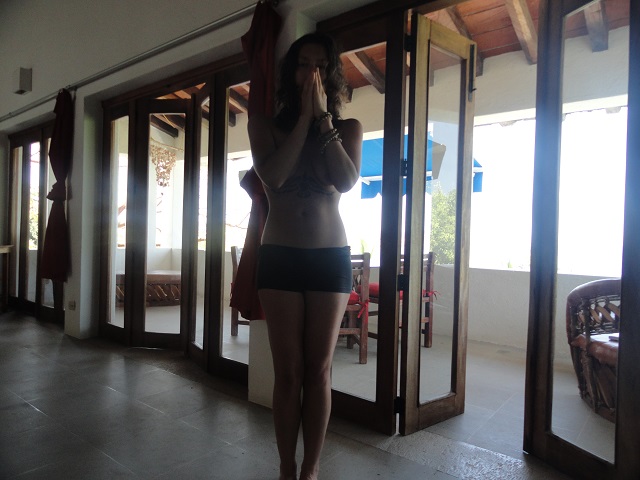
“The greatest prayer is patience.” ~ (not) Buddha
At 16, I had been living with anorexia for four years.
Having an eating disorder was like being surrounded by a pack of snarling wolves. The internal barking and growling I heard was punctuated only by the sharp bites and tearing canines of self-judgment and disregard.
Behind my anorexia hid many things. Like one of those Babushka, Russian stacking dolls, I had several selves inside of me, ones that I would eventually peel apart. But as a teenager, my anorexic self appeared as the tenacious desire to cope with life and the daily anxieties of fitting into it.
At 16, I was tired—bone tired. I had spent years pushing my body to be something it was never meant to be. But despite my exhaustion there was still an inkling inside of me, a wisdom that knew I could get through this earthly obstacle, somehow.
I was fighting to overcome gnarly-toothed demons at an age when I had just barely tasted life.
I knew I needed to start turning the wheels toward more positive practices, rather then the destructive ones that had seemingly pulled me to them and latched on. I had noticed that people who used meditation regularly seemed to have a special edge on this, one that held the gentleness my hurting soul craved.
I was always called to any path that had the word spirit in it, and spirituality obviously had that. So it was in my teens that I decided that Buddhism, and most importantly, meditation, was what would save me from myself. I hadn’t realized yet that radical healing must be done in many different ways and on many different levels—but Buddhism seemed like a good place to start.
For some reason, I I believed meditation would be the skill that would enable me to heal without anyone having to find out about my suffering—the secret of anorexia would be kept just to me.
I had a close friend at that time who came back from living in a cave in India with a shaved head, and wearing golden coloured monk robes. When she told me she was going on retreat for a week with a famous Buddhist teacher, I asked if I could join.
I had no idea what I was getting myself into.
What I hoped I would find there was a savior, someone who would be able to look at me, touch me and then cure me instantly of my disorder. It seemed likely that a highly respected spiritual practitioner would be the one to do that. That, along with the meditation, I believed would do the trick.
At 16, I didn’t understand that mindfulness teachers were ordinary humans too, and that the process of meditation was actually that—a process. I needed someone with super powers and also immediate healing—my body was beginning to fight back against all the abuse, and it wouldn’t be long until I got really sick.
I realized something at that point in my life:
I was not yet sure how to live, nor did I want to die.
It was a shaky trip to the retreat center where I was entering a 10-day silent Vipassana retreat—passana meaning “seeing” and vi meaning “through.” This was a difficult definition for someone with something very large they were trying to hide.
I remember the quiet of that place. It was so still that I could actually feel the vibration of the air that moved around me, and the cells of each participant’s body humming.
The stillness was hard. My bones ached.
By the second day, I felt a building terror. Sitting still, the wolves that regularly surrounded me were now directly in my face, and no one seemed to notice how badly I was hurting. There was a strict routine the retreat followed, and it didn’t seem to involve any spontaneous or miraculous healing.
Sh*t.
By the fourth day, the centre was unbearable. I didn’t understand that this was exactly how it was for many people there.
I called my mother that night in tears and told her I needed to come home, devastated the healing I yearned for hadn’t occurred.
I thought the guru would pry my suffering out of me with his magic, spiritual crow bar. But that, he did not.
When I got home from the retreat, I had lost another five pounds. This was my first attempt at facing my Anorexia with meditation, and the lowest weight I would ever hit.
The following ten years, as my eating disorder morphed and finally dissipated, would show me what meditation was really about: peeling away the layers of my false selves and coming more and more into truth. I was not anorexia, neither was I many of the other things I labeled myself at that age.
At 16, meditation seemed like it would provide me a place to hide while I erased the pain that I was experiencing. Now I see how that first retreat was there to allow me rather to just be—real, messy and hurting.
Now, at 33, my layers of identity continue to be stripped away. I am still not sure what the Babushka at the centre of my soul looks like yet, but I am certain if I continue with mindfulness practices, I will get there.
That meditation retreat I went on way back then did help save me from anorexia, it just took ten years longer then I thought it would.
Patience is a virtue some of us have to grow into.
Author: Sarah Norrad
Image: courtesy of the author
Editor: Emily Bartran








Read 0 comments and reply